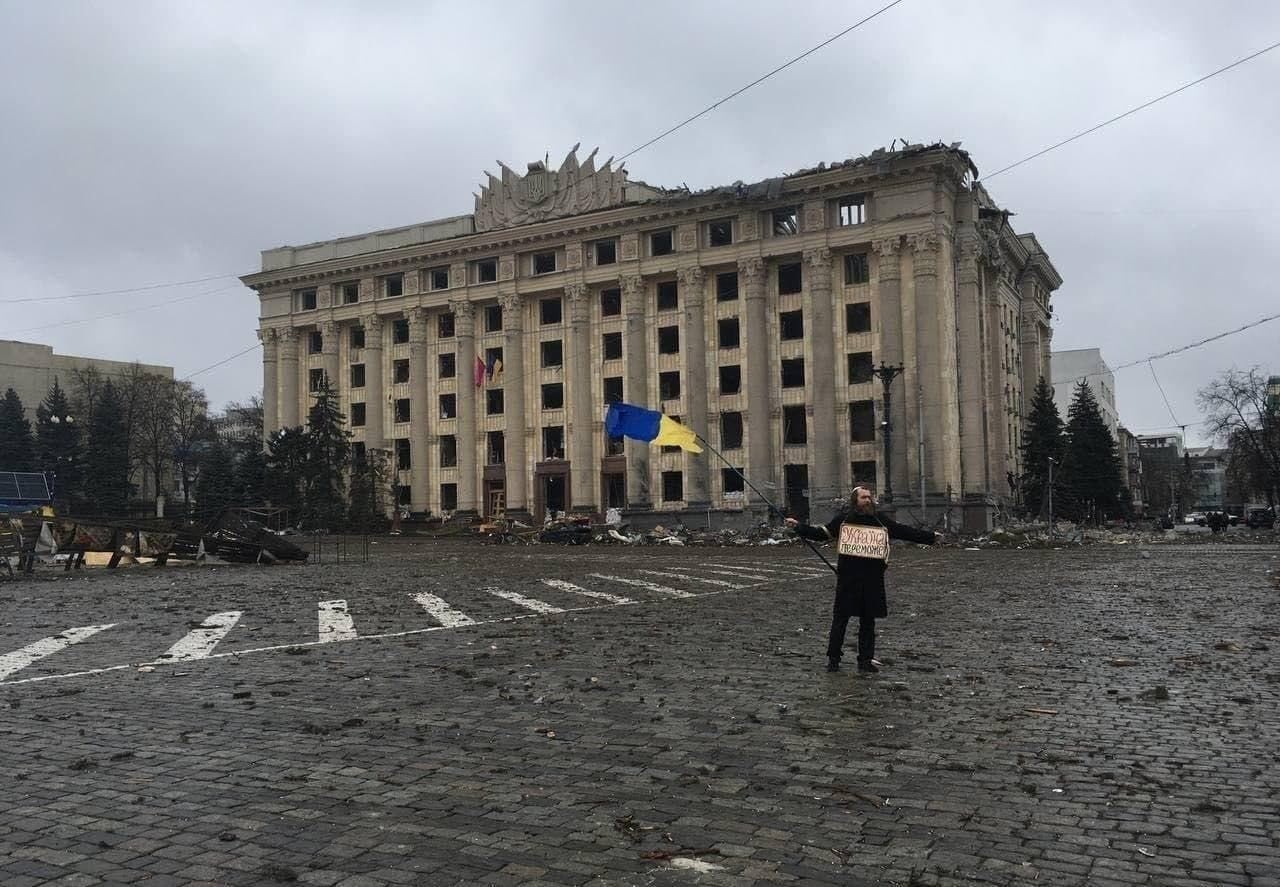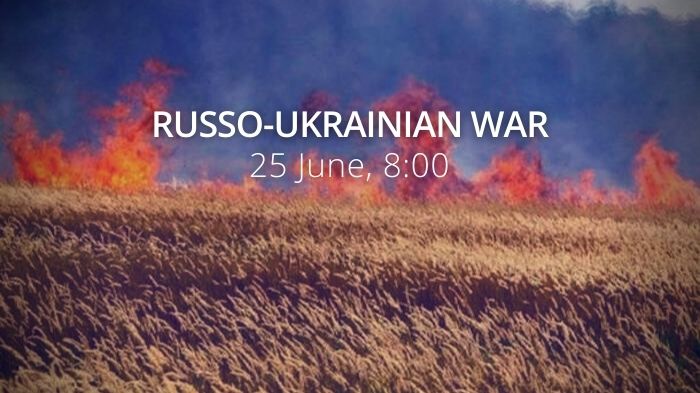Russian forces continued offensive operations along the Donetsk Oblast front line. 'HRW’s allegations that Ukraine used banned mines are outrageous and play into Russia’s hands' – human rights activists. Ukraine shows progress in the fight against corruption in 2022.
Daily overview — Summary report, January 31, 2023
https://twitter.com/War_Mapper/status/1620588438096580613
The General Staff’s operational update regarding the Russian invasion as of 18.00 pm, January 31, 2023 is in the dropdown menu below:
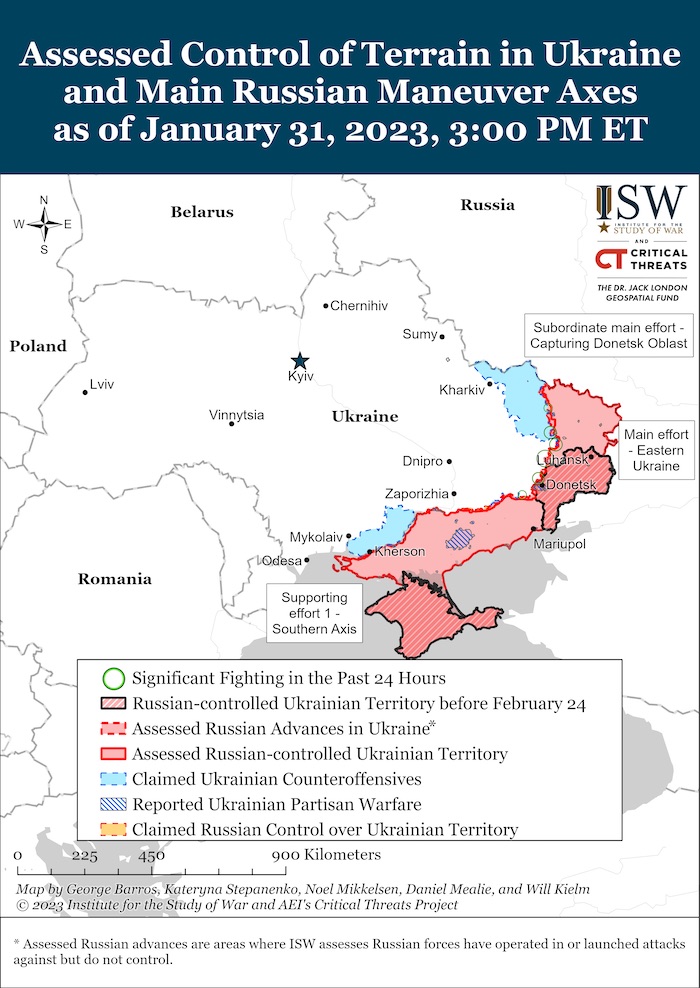

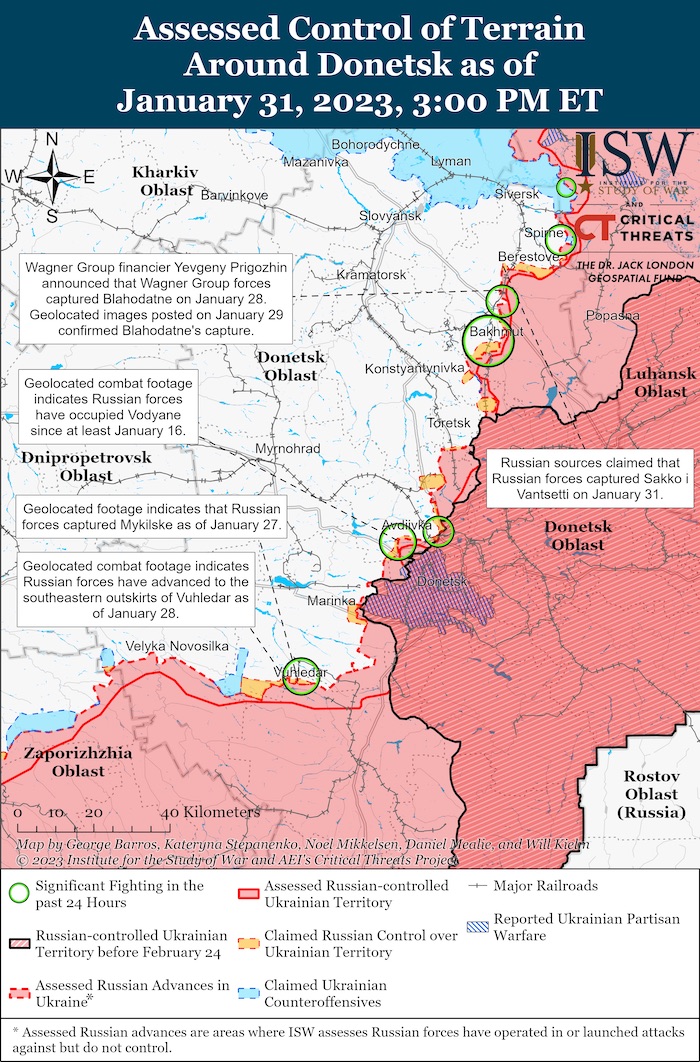
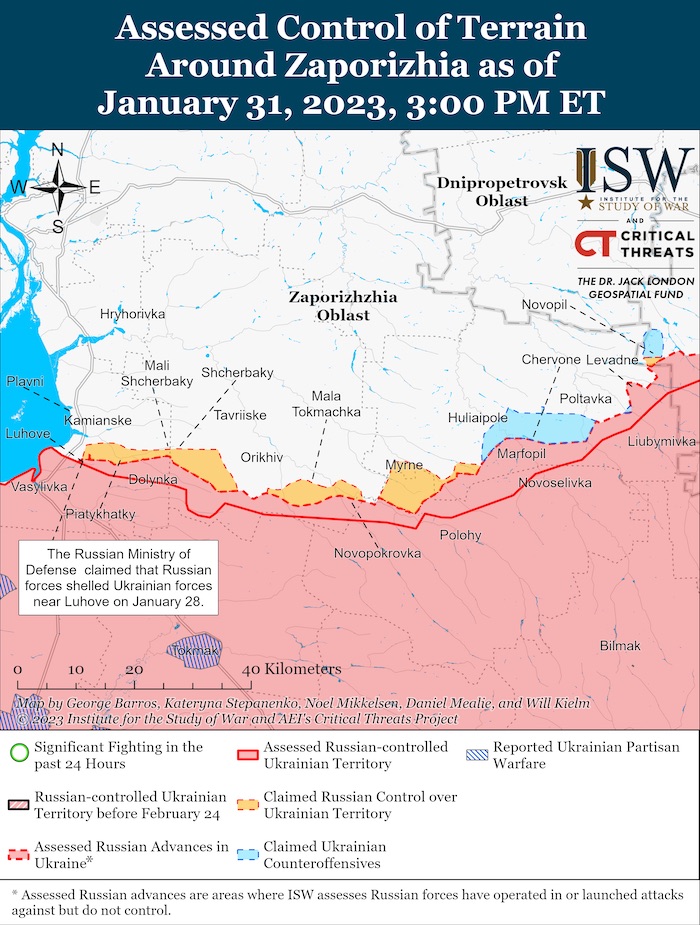
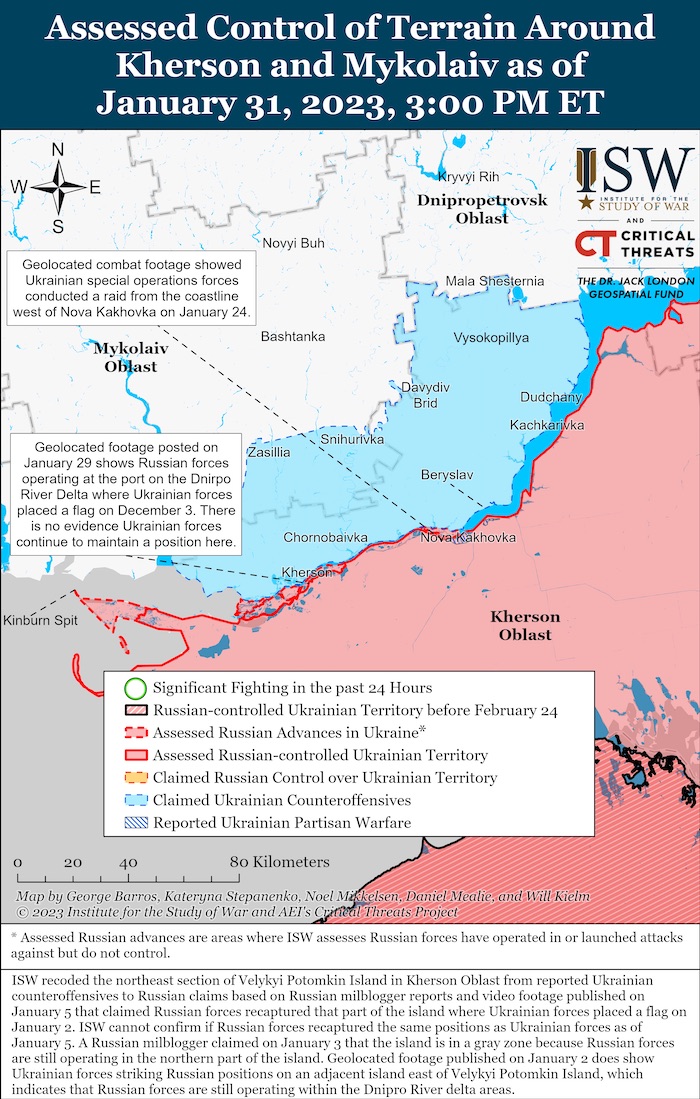
Military Updates
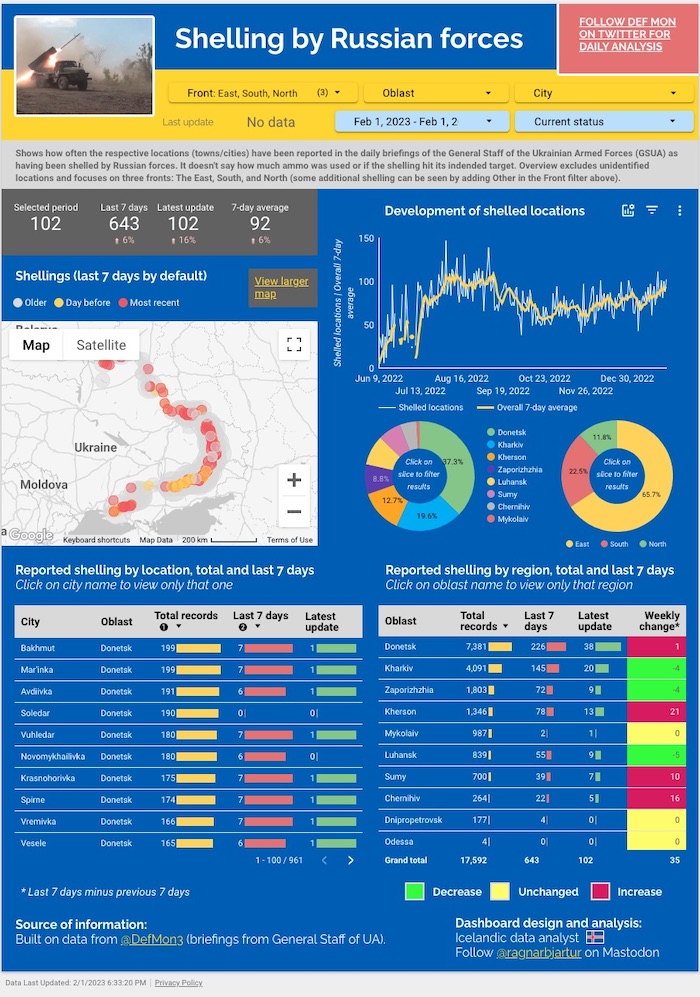
https://twitter.com/EuromaidanPress/status/1620538994365976578
Russia uses Shahed-136 drones in new military tactics against Ukraine. Russia has used both Iranian Shahed-drones and missiles to strike Ukraine’s critical infrastructure. However, the Ukrainian military noticed Russian military changed its tactics of striking crucial energy objects, RFE/RL reported. Compared to the previous attacks, Shahed-136 drones or Kh-55 dummy warheads go in the first wave to recon the positions of the Ukrainian air defense system, and then missiles are launched, says Natalia Humeniuk, head of the joint coordination press center of the Defense Forces of Southern Ukraine.
Ukrainian troops destroy five light motor boats carrying Russian saboteurs – General Staff. Ukraine’s Armed Forces destroyed five light motor boats carrying Russian sabotage and reconnaissance groups on 30 January, the General Staff of the Armed Forces reported.
Ukraine needs up to 200 multi-purpose aircraft to defend its skies – Air Force spox. To defend itself, Ukraine needs to replace its obsolete Soviet-era aircraft of various types with up to 200 planes of a single type – a Western multi-purpose fighter, which can be the F-16, Yurii Ihnat said, the spokesman for Ukraine’s Air Force, in his remarks to the French TV channel La Chaîne Info and in the comments of the Ukrainska Pravda.
According to British Defence Intelligence, (last 48 hours):
https://twitter.com/DefenceHQ/status/1620720684325376002
- In recent days, some of the most intense shelling in the conflict has likely taken place along the Dnipro River in southern Ukraine. This has included continued Russian shelling of Kherson city with artillery firing from the east of the river.
- On 29 January 2023, local authorities reported another three civilians killed in Kherson, while two foreign-owned ships moored on the river were damaged, causing an oil spill. Kherson remains the most consistently shelled large Ukrainian city outside of the Donbas. Russia’s precise rationale for expending its strained ammunition stocks here is unclear.
- However, commanders are likely partially aiming to degrade civilian morale and to deter any Ukrainian counter-attacks across the Dnipro River.
Losses of the Russian army
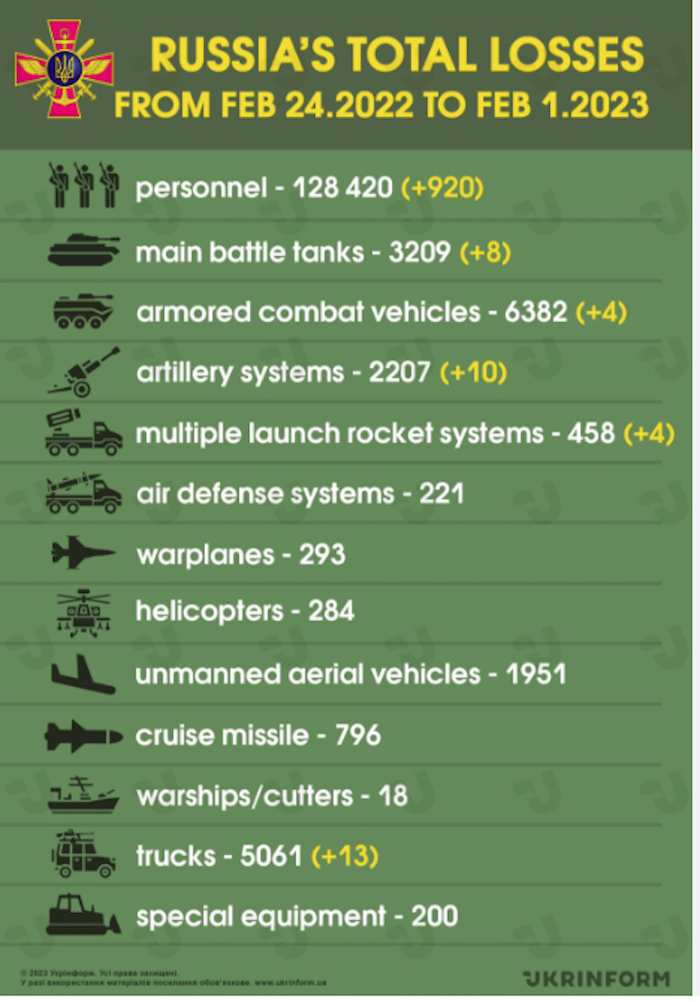
Humanitarian
https://twitter.com/EuromaidanPress/status/1620439027781615617
Ukraine’s ombudsman, Council of Europe Secretary General discuss human rights challenges amid war. On Jan. 30, the Verkhovna Rada Commissioner for Human Rights, Dmytro Lubinets, met with Council of Europe Secretary General Marija Pejčinović Burić to discuss current human rights challenges amid Russia’s war, including the illegal deportation of children and human rights violations in occupied territories of Ukraine.
Two civilians were killed, including a teenager, in Russian shelling of Bakhmut in Donetsk Oblast
Four people were injured in the attack, Pavlo Kyrylenko, the head of Regional Military Administration informed https://t.co/TkAnYB8A1B pic.twitter.com/kEDjIwSyRG
— Euromaidan Press (@EuromaidanPress) January 31, 2023
Environmental
HRW’s allegations that Ukraine used banned mines are outrageous and play into Russia’s hands – human rights activists. On 31 January, Human Rights Watch (HRW) published a report assuming that the Ukrainian army allegedly used PFM-1 anti-personnel mines (“petal mines”) near Izium in Kharkiv Oblast. The use of such anti-personnel mines is a war crime, it is prohibited by the Ottawa Convention, which Ukraine has ratified, but Russia has not. Ukrainian human rights activists have already said that the HRW report fuels Russian propaganda and undermines public support for continued military aid to Ukraine from Western governments.
Human Rights Watch published map of Ukraine without Crimea – UNIAN. The human rights organization Human Rights Watch (HRW) published a map of Ukraine without Crimea in its January 31 report. Crimea on this map was marked with the same grayish color as Russia, UNIAN reports. After the incident gained traction on Ukrainian social media, HRW simply removed the image from the text of the article without any mention of the blunder, UNIAN says.
Legal
Ukraine shows progress in the fight against corruption in 2022, Corruption Perceptions Index reveals
Ukraine's score has increased by one point compared to 2021, and now it ranks 116th out of 180 in the Index scale of the most corrupt countries https://t.co/RT2n0KUr6p pic.twitter.com/SapDaj2L4B
— Euromaidan Press (@EuromaidanPress) January 31, 2023
Support
France to supply 12 additional CAESAR self-propelled guns to Ukraine – Le Monde. France is going to supply 12 additional Caesar guns to Ukraine “in the coming weeks,” those will be “financed as part of the support fund of 200 million euros,” according to the French Minister of the Armed Forces Sébastien Lecornu, Le Monde reports. Previously, France donated 18 Caesar medium-range self-propelled guns to Ukraine.
British Challenger 2 tanks to arrive in Ukraine “before summer” – Ben Wallace. British Challenger 2 tanks donated to Ukraine will arrive on the front line “this side of summer,” UK Defense Minister Wallace said, Reuters reported. Asked in parliament when the 14 Challenger tanks it has agreed to supply would be deployed onto the battlefield, Wallace said: “It’ll be this side of the summer, or May – it’ll be probably towards Easter time.”
France and Australia to provide Ukraine with shells. France and Australia reached an agreement to supply 155-mm shells to Ukraine’s Armed Forces in order to help Ukraine repel the Russian invasion, French Defense Minister Sebastien Lecornu and the Minister of Defence of Australia Richard Marles announced on 30 January 2023. France and Australia signed the agreement on the cooperation between the Australian and French defense industries that will allow them to jointly manufacture 15-mm shells.
New Developments
Ukraine's foreign ministry criticized Croatian President Zoran Milanović on Jan 31 for saying Crimea would never return to Ukrainian control, describing his comment as "unacceptable"https://t.co/q5qnFCDQGA
— Euromaidan Press (@EuromaidanPress) January 31, 2023
NATO states should stop drawing red lines and supply any weapons Ukraine needs – Lithuanian President. NATO countries should stop drawing red lines and supply Ukraine with any weapons it needs, Lithuanian President Gitanas Nausėda told LRT TV on 30 January evening. “I have seen many red lines that have been drawn, and sometimes I even have the impression that these red lines are not drawn by us, the Western countries, the democracies, but that it is the terrorist state of Russia that is trying to draw them through fear and threats. And it is trying to impose them,” he said.
Ukraine seizes USD 870,000 of sanctioned Russian oligarch Deripaska. Ukraine has seized UAH 32 million ($870,000) of Ukraine’s largest producer of metallurgical alumina and aluminum hydroxide, owned by sanctioned Russian oligarch Oleg Deripaska, its Prosecutor General’s Office informed. According to Ekonomichna Pravda, the mentioned company is the Mykolaiv Alumina Plant. In 2022, it was reported that a court transferred this enterprise from the ownership of the Russian oligarch to Ukraine’s ARMA Agency for Investigation and Management of Assets, which deals with assets derived from corruption and other crimes.
Iran, Russia merge banking systems, launch own payment system after SWIFT ban. Russia and Iran are merging their banking systems to get around being banned from SWIFT, the critical communication system for global bank payments. Several Iranian central bank officials confirmed the partnership with Russia’s central bank on Monday, Reuters reported.
Xi Jinping doesn’t want to wind up on the losing side in Ukraine - Opinion
"At the very least the Biden administration can continue pressing China not to provide military equipment to Russia."https://t.co/Qraz2BEBFA
— Euromaidan Press (@EuromaidanPress) January 31, 2023
Assessment
- On the war.
The Institute for the Study of War has made the following assessment as of January 31, 2023:
The introduction of Russian conventional forces to the Bakhmut frontline has offset the culmination of the Wagner Group’s offensive and retained the initiative for Russian operations around the city. The ISW December 27 forecast that the Russian offensive against Bakhmut was culminating was inaccurate.[1] The Wagner Group offensive culminated, as ISW assessed on January 28, but the Russian command has committed sufficient conventional Russian forces to the effort to reinvigorate it, thus forestalling the overall culmination of the offensive on Bakhmut, which continues.[2] The commander of a Ukrainian unit operating in Bakhmut, Denys Yarolavskyi, confirmed that "super qualified" Russian conventional military troops are now reinforcing Wagner Group private military company (PMC) assault units in an ongoing effort to encircle Bakhmut.[3] Another Ukrainian Bakhmut frontline commander, Volodymyr Nazarenko, also confirmed ISW’s observations that the Russian military command committed Russian airborne troops to the Bakhmut offensive.[4] Russian forces are continuing to conduct offensive operations northeast and southwest of Bakhmut and have secured limited territorial gains since capturing Soledar on January 12.[5]
ISW does not forecast the imminent fall of Bakhmut to Russian forces, although the Ukrainian command may choose to withdraw rather than risk unacceptable losses. It is extraordinarily unlikely that Russian forces will be able to conduct a surprise encirclement of Ukrainian forces in Bakhmut. Yaroslavskyi noted that the Ukrainian military command would conduct a controlled withdrawal of forces from Bakhmut to save Ukrainian soldiers’ lives, likely if the Ukrainian command assesses that the risk of an encirclement of the city is imminent.[6] Ukrainian Eastern Grouping of Forces Spokesperson Serhiy Cherevaty stated on January 31 that Ukrainian forces are still able to effectively supply units in Bakhmut and noted that the Ukrainian military command has developed several contingency plans to respond to Russian operations around Bakhmut.[7] Cherevaty added that Russian forces are continuing to suffer heavy casualties and noted that Ukraine’s previous defense and subsequent withdrawal from Sievierodonetsk and Lysychansk over the summer of 2022 exhausted Russian forces and disrupted their plans for an immediate attack on Bakhmut.
Russian officials are again overestimating Russian military capabilities to advance in Donetsk Oblast and in the theater in a short period of time. Head of the Donetsk People’s Republic Denis Pushilin stated on January 31 that the Russian capture of Bakhmut will allow Russia to advance to Kramatorsk and Sloviansk, both approximately 40km northwest of Bakhmut.[8] Wagner Group financier Yevgeny Prigozhin previously claimed that the average pace of Russian advance around Bakhmut was about 100 meters per day, and it took Russian forces eight months to advance from occupied Popasna in Luhansk Oblast and Svitlodarsk to their current positions in the vicinity of Bakhmut (distances of 25km and 22km respectively).[9] Pushilin also claimed that the hypothetical Russian capture of Vuhledar would allow Russian forces to launch offensive operations on Kurakhove, Marinka, and Pokrovsk—despite the inability of Russian forces to capture Marinka since March 17, 2022, when the Russian Ministry of Defense (MoD) falsely claimed to have seized the settlement.[10] Pushilin had also claimed that Russian forces will seize Avdiivka, but has not provided any explanation of how Russian forces will break through almost nine years’ worth of Ukrainian fortifications around the settlement.[11] Pushilin’s expectations for Russia's hypothetical seizure of Bakhmut further demonstrate that Russians are continuing to face challenges in accurately assessing the time and space relationship with the account for Russian military capabilities.
Russian conventional forces may be replacing expended Wagner PMC forces by relocating them from Bakhmut to the frontlines in southern Ukraine.[12] The Head of the Ukrainian Press Center of the Defense Forces of the Tavrisk Direction, Colonel Yevhen Yerin, stated that Russian forces are conducting unspecified force rotations out of Kherson Oblast and that Ukrainian authorities are clarifying reports about Wagner Group forces arriving in the Zaporizhzhia operational direction.[13] Ukrainian officials first reported on Wagner forces arriving in east (left) bank Kherson Oblast on January 15, coinciding with the culmination of the Wagner offensive in Donbas with the capture of Soledar on January 12.[14] Russian forces may be rotating out the culminated and battle-weary Wagner forces in favor of Russian conventional units that have likely been resting and refitting since the Russian withdrawal to the east (left) bank Kherson Oblast in November.[15]
The Russian Ministry of Defense (MoD) may be attempting to fully supplant Wagner forces near Bakhmut and frame the traditional Russian military command structure as the sole victor around Bakhmut, assuming Russian forces eventually take the city. The Russian MoD and Wagner Group financier Yevgeny Prigozhin have made competing claims over recent Russian gains around Soledar and Bakhmut following the capture of Soledar.[16] The Russian MoD claimed that Russian forces captured Blahodatne just west of Soledar on January 31 after Prigozhin claimed that Wagner forces seized the settlement on January 28.[17] Prigozhin is likely overcompensating for Wagner forces’ reduced combat capabilities and reliance on conventional forces by claiming territorial gains before the MoD can feasibly claim them for Russian conventional forces.[18] The Russian MoD likely aims to undermine the Wagner Group’s influence in Ukraine despite the MoD’s reliance on Wagner forces to sustain the Russian effort around Bakhmut since July and to take horrendous losses for minimal territorial gains.[19]
Ukrainian officials continue to support ISW’s assessment that an imminent Russian offensive in the coming months is the most likely course of action (MLCOA) and further suggested that Ukrainian forces plan to launch a larger counteroffensive. Ukrainian National Security and Defense Council Secretary Oleksiy Danilov stated in a January 31 interview with Sky News that Russian forces are preparing for a "maximum escalation" in Ukraine within the next two to three months and may do so as soon as the next two to three weeks to coincide with the first anniversary of the Russian invasion of Ukraine.[20] Ukrainian Main Military Intelligence Directorate (GUR) Head Kyrylo Budanov stated in a January 31 interview with the Washington Post that Russian forces will focus on occupying a larger area of Luhansk and Donetsk oblasts, supporting ISW’s assessment that Russian forces appear to be preparing for an imminent offensive in eastern Ukraine, particularly in Luhansk Oblast.[21] Budanov stated that there are currently 326,000 Russian forces fighting in Ukraine, excluding the roughly 150,000 mobilized personnel still in training grounds that Russian forces have reportedly not yet committed to hostilities.[22] The Russian military will likely continue to accumulate conventional forces in Luhansk Oblast and increase the deployment of remaining mobilized personnel to eastern Ukraine in support of an imminent decisive strategic effort in western Luhansk Oblast.[23] Danilov suggested that Ukrainian forces have their own plans for operations in the coming months, and Budanov stated that Ukrainian forces must return Crimea to Ukrainian control by the summer of 2023.[24] Budanov has recently stated that Ukrainian forces intend to launch a major counteroffensive throughout Ukraine in the spring of 2023 "from Crimea to Donbas."[25]
Prominent Russian milbloggers continue to expose Russian military failures in Ukraine through increasingly public and elevated platforms. A prominent Russian milblogger claimed on live Russian state TV that Russian Airborne Forces (VDV) lost 40-50% of their personnel between the start of Russia’s invasion of Ukraine and September of 2022, although ISW cannot independently confirm the accuracy of the milblogger’s assessment.[26] The public reporting of this significant figure, regardless of its accuracy, notably undermines efforts from the Russian Ministry of Defense (MoD) to minimize Russian causalities reported in the Russian information space. The Kremlin has recently attempted to integrate some select milbloggers, including this one, into its narrative control by offering them platforms on Russian state broadcasters while also attempting to resurrect censorship efforts targeting the wider community of milbloggers that are critical of the Kremlin and the Russian Ministry of Defense (MoD).[27] The Kremlin‘s effort to coopt a select group of milbloggers by giving them more public and elevated platforms may backfire as milboggers may seize the opportunity to appeal to the Russian ultranationalist community that has been increasingly critical of the Kremlin’s conduct of the war.[28]
Russia continues to weaponize counterterrorism laws to justify domestic repressions. Russian sources reported on January 31 that the Central Military District Court found Vladislav Borisenko guilty of a terrorist act and sentenced him to 12 years in prison for his role in a May 2022 Molotov cocktail attack on the Nizhnevartovsk military registration office in Khanty-Mansi Okrug.[29] This is notably the first instance of the perpetrator of an attack on a military registration office being officially charged with committing a terrorist act.[30] The apparent elevation of charges for such incidents from destruction of property and hooliganism indicate that the Russian judicial system is increasingly seeking to impose harsher punishments on acts of domestic dissent as the war in Ukraine continues, as ISW has previously assessed.[31] Russian President Vladimir Putin additionally signed a decree on January 31 that simplifies the process of implementing terror threat alerts in Russia.[32] The decree allows Russian regions to introduce an elevated "terrorist level" for an indefinite period, thus negating the previous 15-day limit.[33] The January 31 decree is an expansion of Putin’s October 19 martial law decree, which introduced varying levels of "martial law readiness" in occupied regions of Ukraine and Russian border regions.[34] The new decree will allow Russian regions operating on a "yellow level" of terrorist threat (as in Belgorod, Bryansk, and Kursk Oblasts) to stop and search vehicles on administrative borders to weapons and explosives, activities that were previously allowed only in "red level" regions.[35] The continued legislative manipulations of terrorism as a legal concept are allowing Russian authorities greater scope to crack down on domestic dissent and on any activities that are deemed contrary to Russian interests.
Key Takeaways
- The introduction of Russian conventional forces to the Bakhmut frontline has offset the culmination of the Wagner Group’s offensive and retained the initiative for Russian operations around the city. ISW's December 27 forecast that the Russian offensive against Bakhmut was culminating was inaccurate.
- ISW does not forecast the imminent fall of Bakhmut, and it is extraordinarily unlikely that Russian forces will be able to conduct a surprise encirclement of Ukrainian forces in Bakhmut.
- Russian military command is overestimating Russian military capabilities to advance rapidly in Donetsk Oblast and in the theater.
- Russian conventional forces may be replacing expended Wagner PMC forces by relocating them from Bakhmut to the Zaporizhzhia Oblast front line.
- The Russian Ministry of Defense (MoD) may be attempting to fully supplant Wagner forces near Bakhmut to frame the traditional Russian military command structure as the sole victor around Bakhmut, assuming Russian forces take the city.
- Ukrainian officials continue to support ISW’s assessment that an imminent Russian offensive in the coming months is the most likely course of action (MLCOA) and further suggested that Ukrainian forces plan to launch a larger counteroffensive.
- Prominent Russian milbloggers continue to expose Russian military failures in Ukraine through increasingly public and elevated platforms.
- Russia continues to weaponize counterterrorism laws to justify domestic repressions.
- Russian forces continued limited ground attacks to regain lost positions along the Svatove-Kreminna line on January 31.
- Russian forces continued offensive operations along the Donetsk Oblast front line.
- Russian forces are unlikely to benefit significantly elsewhere in eastern Ukraine from their localized offensive around Vuhledar.
- Russian forces are likely prioritizing sabotage and reconnaissance activities over territorial gains in southern Ukraine.
- Russian Prosecutor General Igor Krasnov acknowledged Russian mobilization failures in an attempt to frame implementation failures and policy violations as resolved.
- Russian occupation authorities continue to use youth engagement and education programs to consolidate social control of occupied territories.


